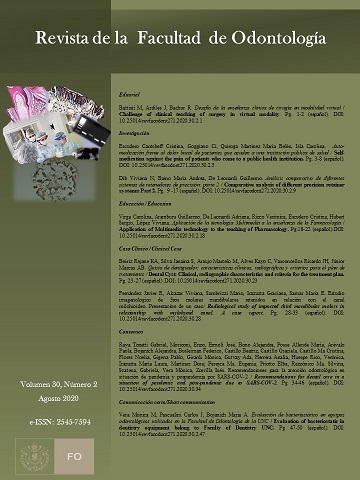Application of multimedia technology to the teaching of Pharmacolog
Abstract
The exhibition classes are not very motivating for the students due to the various limitations that include passivity and loss of student attention. A proposal based on an active learning methodology was proposed, seeking that students creatively address the resolution of problematic situations around the contents of the Pain and Inflammation didactic unit, then evaluated through the presentation of videos produced by the students. Material and methods: The experience began with the conduct of a survey among students to learn about previous experience in the use of videos for educational purposes and ultimately assess the initiative implemented. Students were divided into groups and work slogans were established, guiding the teams constituted in the selection of the group of drugs to work. At the end of the Pain and Inflammation Unit, the contents were integrated and the students presented the videos they had produced to address the proposed topics. Results: 20 videos were presented. The valuation of the productions presented was very good from the conceptual, technical, aesthetic point of view and of the contents addressed. All the groups concluded satisfactorily with the elaboration of their recording projects. After the development of the experience, it was concluded that the use of technology becomes an ally to promote the effective learning of Pharmacology, given the benefits obtained from using moving images instead of traditional teaching methods
References
1. Boude Figueredo O, Medina Rivilla A., Desarrollo de competencias a través de un ambiente de aprendizaje mediado por TIC en educación superior. Educ Med Super [Internet]. 2011; 25(3). Disponibleen:http://scieloprueba.sld.cu/scielo.php?script=sci_arttext&pid=S0864-21412011000300007&lng=es
2. Cuenca Doimeadios E, Reyes Hernández D, Ellis Yards ML, Navarro Hernández M, Alvelo Pérez D., Recursos de aprendizaje en la asignatura de Psiquiatría para la formación del Médico Integral Comunitario. EducMedSuper [Internet]. 2013; 27(1). Disponible en: http://scieloprueba.sld.cu/scielo.php?script=sci_arttext&pid=S0864- 21412013000100005&lng=es
3. García Garcés H, Navarro Aguirre L, López Pérez M, Rodríguez Orizondo MF., Las Tecnologías de la Información y la Comunicación en la salud y la educación médica. EDUMECENTRO [Internet]. 2014; 6(1). Disponible en: http://www.revedumecentro.sld.cu/index.php/edumc/article/view/373/570
4. Puig Rosell W, González Hourruitiner A., Criterios de clasificación y selección de los medios de enseñanza. Educ Med Super [Internet].http://www.revedumecentro.sld.cu 90 2014] 2012; 26(2). Disponible en: http://scieloprueba.sld.cu/scielo.php?script=sci_arttext&pid=S0864- 21412012000200015&lng=es
Published
Issue
Section
License

This work is licensed under a Creative Commons Attribution-NonCommercial-ShareAlike 4.0 International License.
Aquellos autores/as que tengan publicaciones con esta revista, aceptan los términos siguientes:
- Los autores/as conservarán sus derechos de autor y garantizarán a la revista el derecho de primera publicación de su obra, el cuál estará simultáneamente sujeto a la Licencia de reconocimiento de Creative Commons que permite a terceros:
- Compartir — copiar y redistribuir el material en cualquier medio o formato
- La licenciante no puede revocar estas libertades en tanto usted siga los términos de la licencia
- Los autores/as podrán adoptar otros acuerdos de licencia no exclusiva de distribución de la versión de la obra publicada (p. ej.: depositarla en un archivo telemático institucional o publicarla en un volumen monográfico) siempre que se indique la publicación inicial en esta revista.
- Se permite y recomienda a los autores/as difundir su obra a través de Internet (p. ej.: en archivos telemáticos institucionales o en su página web) después del su publicación en la revista, lo cual puede producir intercambios interesantes y aumentar las citas de la obra publicada. (Véase El efecto del acceso abierto).

